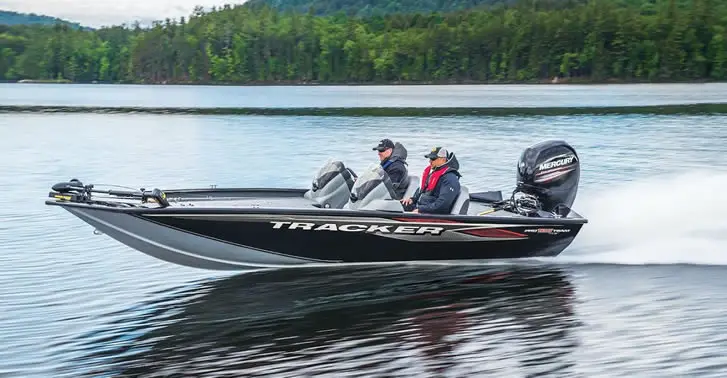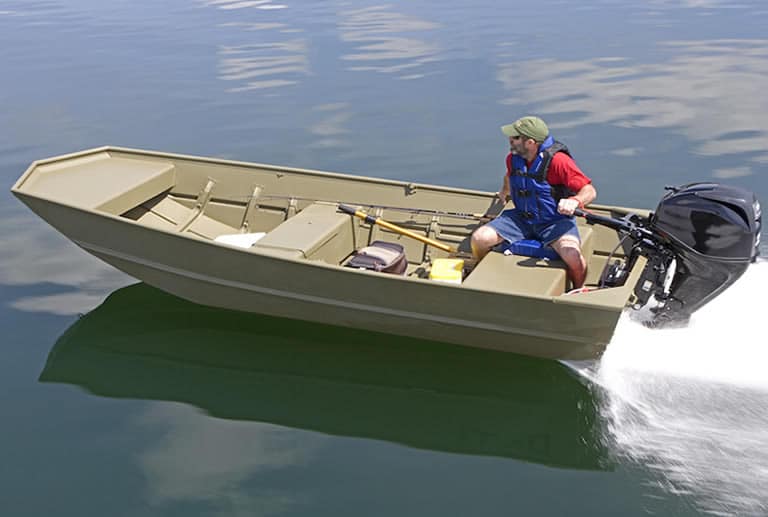So, here I show you exactly how to how to get a boat on plane. I have also added a troubleshooting section that covers the 3 common problems behind a boat that won’t plane out.
Contents
Guide To Planning A Boat
How to get a boat on plane – here are the 5 easy steps to getting a boat on plane fast.
- With the motor trimmed in towards the transom gently increase speed.
- As you increase speed the bow of the boat will begin to lift up and out of the water.
- When this happens trim the motor up away from the transom.
- When the boat starts to slow stop trimming.
- The bow will drop and the boat will be on plane.
To understand each of the above points in more detail please review the rest of this article.
How planning a boat works
When a flat bottom boat (such as a Jon boat) is sitting in the water at rest it has static buoyancy – the water displacement is keeping the boat afloat.
As the boat is propelled through the water the dynamics of how the boat interacts with the water changes.
As thrust and speed are increased, via an outboard motor, this creates hydrodynamic lift.
When thrust and speed from the motor is increased and hydrodynamic lift occurs the front of the boat starts to lift out of the water as the motor is trimmed.
As speed starts to decrease trimming is decreased, dropping the bow of the boat.
So, the boat is now essentially riding over its bow wave which reduces the area of the boat that is in the water thus reducing drag on the boat.
It is at this point that the boat is on plane.
5 Steps To Getting A Boat On Plane
As you can see from the above explanation getting a boat on plane simply requires an increase in thrust and speed from the outboard motor in conjunction with trimming.
However, there are a few things you need to know and get right before you can get your boat planning.
As most personal boats are relatively small vessels the positioning of crew is important as this will greatly affect the boat’s ability to plane effectively.
For example, if crew and passengers sit on only one side of the boat then it will not ride level.
If everyone sits at the aft of the boat then the stern will sit too low in the water and getting it up onto plane will be extremely difficult.
Ensure all crew and passengers are evenly distributed on the boat.
This also applies to gear.
Good distribution of weight on a boat is essential if you want to get the boat on plane.
Below are the 5 steps to get your boat on plane.
Step 1: Trim the motor
The first step is easy for most flat bottom boat owners as they seldom find themselves on troubled water anyway (being used on inland waters).
But, just in case you own a semi-v Jon and like rough water boating you should ensure you first practice planning your boat on calm water.

In calm conditions it will be easier to detect how even small throttle adjustments affect your boat’s trajectory and performance.
Start with the motor trimmed in toward the transom. Slowly increase the speed.
Avoid creating too much instant thrust i.e. don’t just go for full throttle!
Step 2: Increase your speed steadily
As your speed increases you will see the bow of your boat start to lift.
Keep increasing your speed until you see the bow start to drop.
At this point the boat will be coming onto plane but you aren’t quite there yet.
Be aware that as the boat begins its process on getting on plane the bow will rise so much that you are unlikely to be able to see in front of the boat.
So make sure you do this when you have a clear pathway in front of you.
Step 3: Trim the prop
Without advancing the throttle trim the prop up and away from the transom.
As you trim up your outboard motor the speed of your boat will increase even though the RPMs of the motor will stay the same.
When the boat starts to slow stop trimming.
Using this trimming technique will allow you to lower the bow of the boat so the whole boat starts riding over the water.
Step 4: As the boat slows stop trimming
As you practice, start off with the view of less trim is better than too much.
If possible set yourself up on a long stretch of water where you have plenty of time of get the hang of lifting the bow.
Keep in mind that you don’t want the bow to rise too high when trimming as this will depress the stern making planning impossible.
Additionally if you trim too much the prop may actually start to ventilate as it comes out of the water.
You also want to avoid “porpoising” where the bow continually lifts and falls.
When the boat porpoises it will be much more difficult to control the boat plus your speed will start to drop and you will not able to get the boat on plane.
Step 5: Allow the bow to drop & maintain speed
As you gain more proficiency at planning your boat you will start to notice differences in motor sound.
When you trim the sound from the motor changes slightly.
If the sound of the outboard increases a lot then you may have trimmed too far.
If you don’t hear any difference in the sound at all then you may not be trimming enough.
A Jon boat on plane (video)
Troubleshooting The 3 Reasons Why Your Boat Boat Won’t Plane Out
What do you do if you just can’t get your boat on plane?
Below are some of the most common reasons for a non planning Jon boat and how to fix them.
What do you do when your Jon boat won’t plane out?
As a Jon boat is lightweight and flat-bottomed with a shallow draft it really doesn’t take much to get it on plane.
If your Jon boat won’t plane there is usually a very simple explanation and simple fix.
Let’s take a look at these fixes now.
When a boat won’t plane out there are 3 root causes
Many Jon boat owners have asked me why their boats won’t plane.
In almost every case when I look at their boat setup I find that their “plane” problem falls into one of the three most common causes and the fixes are pretty simple.
To show you how two of these causes can affect a boat’s ability to plane I will use an example from my own life where one of my buddies couldn’t get his Jon boat on plane.
Jake was actually making the two most common mistakes when it comes to getting a Jon on plane and so he is a perfect example of what not to do (sorry Bud).
1. Insufficient motor power will prevent a boat getting on plane
Okay, so I was once asked by my friend Jake why he couldn’t get his 14 foot Jon boat on plane.
When I took a look at his boat setup it was clear to me exactly why he could not get the Jon to plane out, even when it was empty.
Jake was powering his aluminum Lund 1448 with a 6 HP outboard trolling motor. In my opinion he was lucky he could get the boat moving never mind get it on plane. 😉
Obviously he needed to fit a more powerful motor to his boat so it could provide the thrust and speed needed to get the boat to plane out.
This is a simply fix and may seem obvious but it is surprising how often guys don’t realise that they are either under-powering or overpowering (brings problems of its own) their boats.
So, be sure you have the correct outboard motor for your Jon boat and you will find that getting on plane will be easy.
2. A boat with bad weight distribution will never plane out
The second mistake Jake was making on his Jon boat was that he had not distributed the weight of his load correctly.
Being both a keen hunter and angler Jake has his boat kitted out for carrying gear and catch.
He built some storage compartments at the bow end of the boat and, even to this day, tends to stow most of his gear at that end of the boat.
Unfortunately this can can a negative impact on performance.
Being bow heavy will tend to stop the bow from lifting making it impossible to get the boat on plane.
Obviously with a powerful enough outboard motor this would not be a problem.
However, if you are running a boat with a motor that is at the lower end of its capacity then being bow heavy will affect the boats ability to plane.
So keep this in mind when choosing an outboard.
If you feel that your outboard motor is powerful enough to plane the boat but you can’t get it on plane then try redistributing your load to take weight off the bow end of the boat.
If your boat will still not plane out then you need a more powerful outboard motor or need to take a look at your trimming technique.
Alternatively, you may have an underperforming outboard motor.
3. A heavy load on a boat will also prevent it from getting on plane
A heavy load can also affect a boat’s ability to plane.
Even if you have distributed the weight evenly on your boat, ensuring it is not too bow heavy, the weight load can still stop the bow from lifting. This will thus prevent the boat from getting on plane.
In such a case, the two options you have open to you are to lighten the load or get a more powerful outboard.
Summary: How To Get A Boat On Plane & The 3 Reasons It Won’t Plane Out
Getting a boat on plane only takes 5 steps
Practice on calm water until you are proficient at getting your boat on plane.
Start with the motor trimmed in towards the transom.
Then gently increase the speed until the bow lifts up and out of the water.
Then trim the motor up away from the transom.
When the boat starts to slow down stop trimming.
The bow will drop and the boat will be on plane sitting higher on the water than it was before.
There are 3 common reasons when a boat won’t plane out
There are 3 main reasons for not being able to get your boat on plane.
- The boat is overloaded at the bow. You need to distribute the weight of the load better on the boat.
- If the boat is carrying a heavy load, regardless of weight distribution, it can still be difficult to get on plane.
- The outboard is not powerful enough for the boat size.
If your boat won’t plane out then it is either too heavy at the bow, carrying too heavy a load or the outboard motor isn’t powerful enough.

